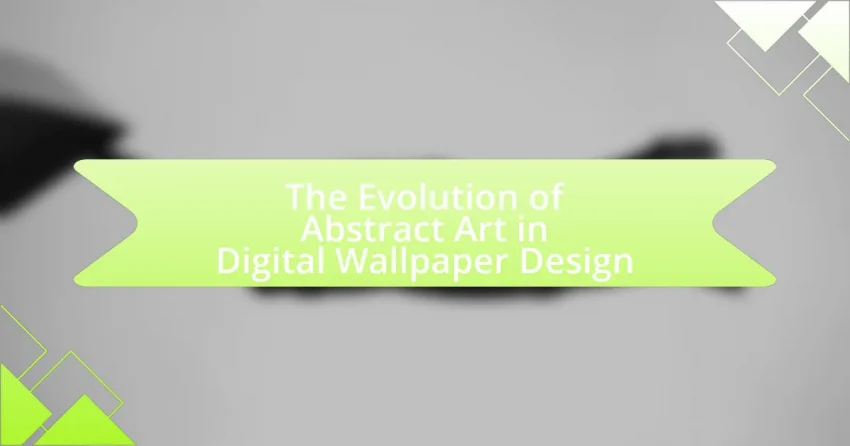The article examines the evolution of abstract art in digital wallpaper design, tracing its development from early 20th-century artistic movements to contemporary digital practices. It highlights key historical milestones, such as the influence of abstract expressionism and the advent of digital tools that have transformed artistic expression. The discussion includes the impact of technology on design techniques, the significance of abstract art in enhancing aesthetic appeal, and current trends in the industry. Additionally, it addresses challenges faced by artists, including market saturation and copyright issues, while offering best practices for creating and marketing abstract digital wallpapers.
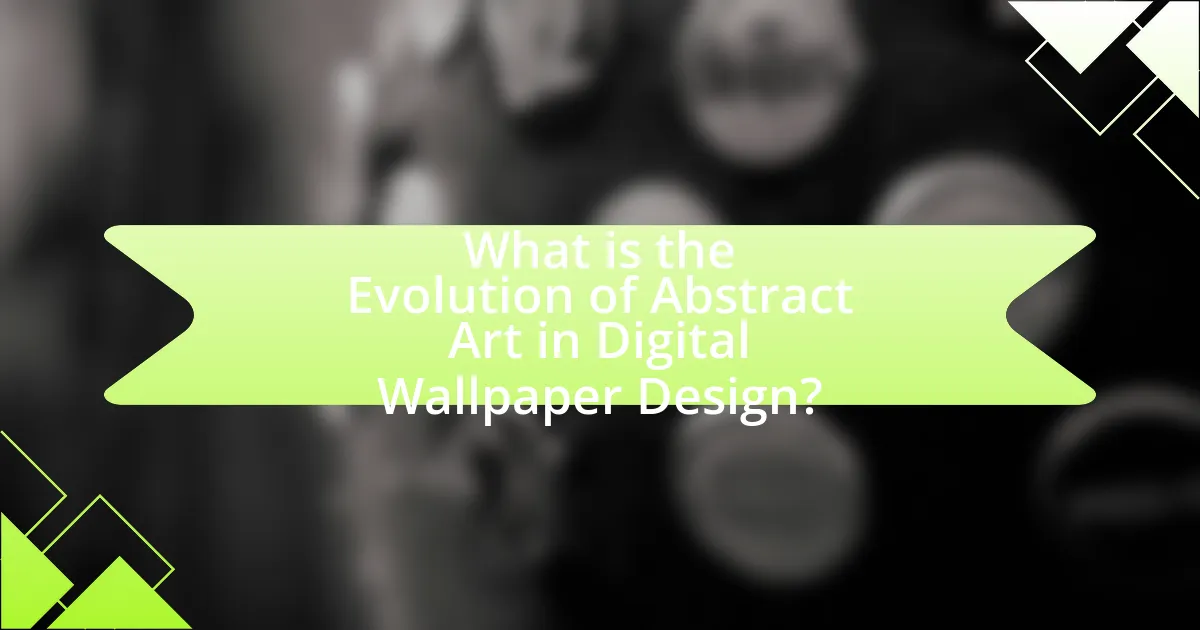
What is the Evolution of Abstract Art in Digital Wallpaper Design?
The evolution of abstract art in digital wallpaper design reflects a transition from traditional artistic methods to modern digital techniques. Initially, abstract art emerged in the early 20th century, with artists like Wassily Kandinsky and Piet Mondrian pioneering non-representational forms. As technology advanced, the introduction of digital tools in the late 20th century allowed artists to create complex patterns and textures that were previously unattainable.
By the 2000s, digital wallpaper design began incorporating abstract art, utilizing software like Adobe Photoshop and Illustrator to manipulate shapes, colors, and forms. This shift enabled designers to produce high-resolution wallpapers that could be easily customized and distributed. The rise of digital platforms and social media further accelerated this trend, allowing for greater visibility and accessibility of abstract designs.
Today, abstract art in digital wallpaper design continues to evolve, with trends such as generative art and 3D modeling pushing the boundaries of creativity. The integration of artificial intelligence in design processes is also shaping the future of abstract wallpaper, enabling unique, algorithm-driven patterns that adapt to user preferences. This ongoing evolution highlights the dynamic relationship between technology and artistic expression in the realm of digital wallpaper design.
How has abstract art influenced digital wallpaper design over time?
Abstract art has significantly influenced digital wallpaper design by introducing innovative patterns, colors, and forms that prioritize visual expression over representational accuracy. This influence began in the early 20th century with movements like Cubism and Abstract Expressionism, which emphasized non-representational forms and vibrant color palettes. As digital technology advanced, designers adopted these abstract principles, leading to the creation of wallpapers that feature bold geometric shapes, fluid lines, and dynamic color gradients. For instance, the rise of software tools in the 1990s allowed artists to experiment with digital textures and layering techniques, resulting in wallpapers that reflect the spontaneity and emotional depth characteristic of abstract art. This evolution is evident in contemporary digital wallpaper collections that often draw inspiration from renowned abstract artists, showcasing how the principles of abstraction continue to shape visual aesthetics in digital design.
What are the key historical milestones in abstract art that impacted digital wallpaper?
Key historical milestones in abstract art that impacted digital wallpaper include the emergence of abstract expressionism in the mid-20th century, which emphasized color and form over representational accuracy, influencing digital design aesthetics. The works of artists like Jackson Pollock and Mark Rothko introduced concepts of spontaneity and emotional resonance, which are now integral to digital wallpaper designs that prioritize visual impact. Additionally, the advent of computer graphics in the 1980s allowed for the exploration of abstract forms in digital media, leading to the creation of wallpapers that reflect the principles of abstraction, such as geometric patterns and vibrant color palettes. The integration of technology with abstract art has enabled designers to manipulate and reproduce these artistic elements at scale, making them accessible for digital wallpaper applications.
How did technological advancements shape the evolution of abstract art in this medium?
Technological advancements significantly shaped the evolution of abstract art in digital wallpaper design by enabling artists to utilize new tools and techniques that expanded creative possibilities. The introduction of software like Adobe Photoshop and Illustrator allowed for intricate layering, manipulation of colors, and the creation of complex patterns that were previously difficult to achieve. Additionally, advancements in computer graphics technology, such as high-resolution displays and 3D rendering, provided artists with the ability to create immersive and visually striking designs. These tools facilitated the exploration of new styles and concepts within abstract art, leading to a diversification of visual language and expression in digital wallpaper design.
Why is abstract art significant in the context of digital wallpaper design?
Abstract art is significant in the context of digital wallpaper design because it allows for the exploration of color, form, and texture without the constraints of representational accuracy. This freedom enables designers to create visually stimulating environments that can evoke emotions and set moods, which is essential in interior design and personal spaces. The use of abstract art in digital wallpaper has been supported by trends in contemporary design that prioritize individuality and creativity, as seen in the rise of customizable wallpaper options that reflect personal aesthetics. Furthermore, studies indicate that environments featuring abstract designs can enhance creativity and reduce stress, making them particularly valuable in both residential and commercial settings.
What emotional responses does abstract art evoke in digital wallpaper?
Abstract art in digital wallpaper evokes a range of emotional responses, including feelings of tranquility, inspiration, and introspection. The use of vibrant colors and dynamic shapes can stimulate creativity and provoke thought, while softer palettes may promote relaxation and calmness. Research indicates that abstract art can elicit personal interpretations, allowing viewers to connect emotionally based on their individual experiences and perceptions. For instance, a study published in the journal “Psychology of Aesthetics, Creativity, and the Arts” by Silvia and Nusbaum found that exposure to abstract art can enhance mood and foster a sense of well-being.
How does abstract art enhance the aesthetic appeal of digital wallpapers?
Abstract art enhances the aesthetic appeal of digital wallpapers by introducing unique visual elements that evoke emotion and stimulate creativity. The use of bold colors, dynamic shapes, and non-representational forms in abstract art allows for a diverse range of interpretations, making digital wallpapers more engaging and visually striking. Research indicates that abstract designs can increase viewer interest and satisfaction, as they often encourage personal reflection and imagination, which is supported by studies showing that abstract visuals can enhance mood and cognitive engagement.
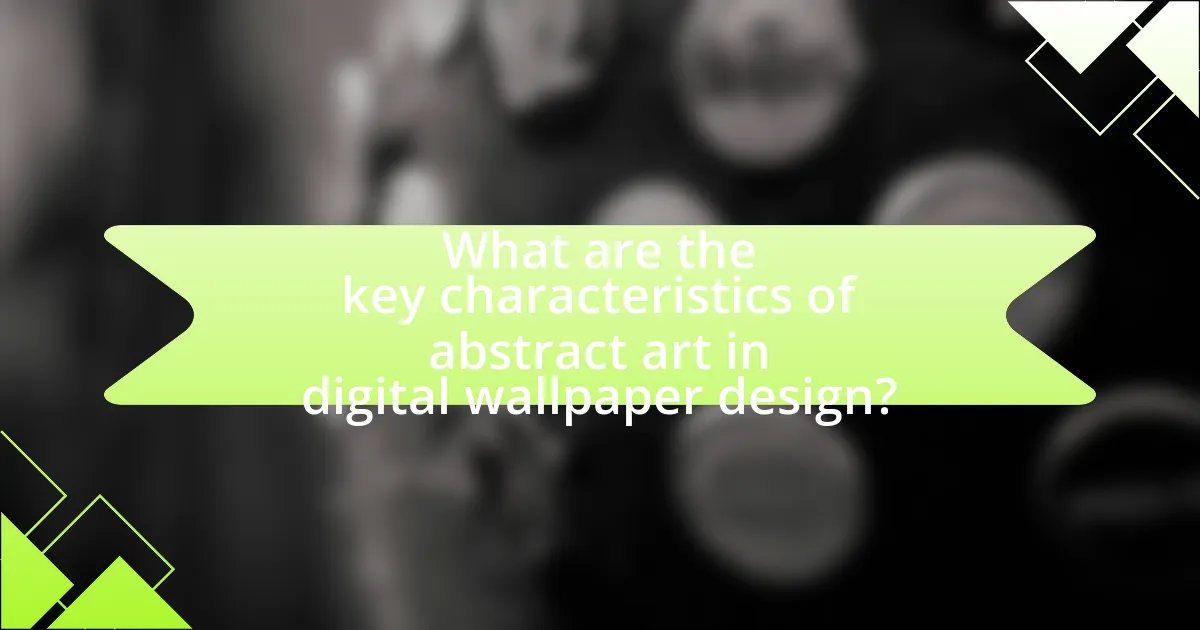
What are the key characteristics of abstract art in digital wallpaper design?
The key characteristics of abstract art in digital wallpaper design include the use of non-representational forms, vibrant colors, and dynamic compositions. Non-representational forms allow for the expression of emotions and ideas without depicting real-world objects, enabling a focus on shapes and lines. Vibrant colors enhance visual impact and evoke specific feelings, while dynamic compositions create movement and energy within the design. These elements collectively contribute to the immersive experience of digital wallpapers, making them visually engaging and emotionally resonant.
What visual elements define abstract art in this context?
Visual elements that define abstract art in the context of digital wallpaper design include color, shape, line, and texture. These elements are utilized to create compositions that do not represent recognizable objects, focusing instead on the emotional and aesthetic experience. For instance, vibrant color palettes can evoke specific moods, while geometric shapes can create a sense of order or chaos. The use of dynamic lines can guide the viewer’s eye through the design, and varied textures can add depth and interest. This approach aligns with the principles of abstract art, which prioritize expression over representation, as seen in the works of artists like Wassily Kandinsky, who emphasized the emotional power of color and form.
How do color, shape, and texture play a role in abstract digital wallpapers?
Color, shape, and texture are fundamental elements that significantly influence the aesthetic appeal and emotional impact of abstract digital wallpapers. Color sets the mood and can evoke specific feelings; for instance, warm colors like red and orange can create a sense of energy, while cool colors like blue and green can induce calmness. Shape contributes to the overall composition and can guide the viewer’s eye, with geometric shapes often conveying order and structure, while organic shapes may evoke a sense of fluidity and movement. Texture adds depth and interest, enhancing the visual experience by simulating tactile sensations or creating contrast between smooth and rough elements. Research indicates that these elements work together to create a cohesive visual narrative, engaging viewers and enhancing their emotional connection to the artwork.
What techniques are commonly used to create abstract designs in digital wallpapers?
Common techniques used to create abstract designs in digital wallpapers include layering, blending modes, and the use of geometric shapes. Layering allows artists to build complex images by stacking multiple elements, while blending modes enable the manipulation of how layers interact with each other, creating unique visual effects. Additionally, geometric shapes can be combined and distorted to form intricate patterns, contributing to the overall abstract aesthetic. These methods are widely utilized in digital art software, such as Adobe Photoshop and Illustrator, which provide tools specifically designed for these techniques, reinforcing their prevalence in the creation of abstract digital wallpapers.
How do different styles of abstract art manifest in digital wallpaper design?
Different styles of abstract art manifest in digital wallpaper design through the use of color, form, and composition, reflecting the unique characteristics of each style. For instance, geometric abstraction often employs sharp lines and bold colors, creating a sense of order and structure, while fluid abstraction utilizes organic shapes and gradients to evoke emotion and movement. The integration of these elements in digital wallpaper allows for a diverse range of visual experiences, catering to various aesthetic preferences. Historical movements, such as Abstract Expressionism, have influenced contemporary digital designs by emphasizing spontaneity and personal expression, which can be seen in wallpapers that feature dynamic brush strokes and vibrant palettes. This evolution showcases how traditional abstract art principles are adapted to modern digital formats, enhancing both artistic expression and user engagement in interior design.
What are the major styles of abstract art used in digital wallpapers?
The major styles of abstract art used in digital wallpapers include geometric abstraction, organic abstraction, and lyrical abstraction. Geometric abstraction focuses on the use of shapes, lines, and colors to create a composition that emphasizes form over representation, often seen in minimalist designs. Organic abstraction, on the other hand, incorporates fluid shapes and natural forms, evoking a sense of movement and harmony, which is popular in nature-inspired wallpapers. Lyrical abstraction emphasizes emotional expression through spontaneous brushwork and vibrant colors, creating dynamic and visually engaging backgrounds. These styles reflect the diverse approaches to abstract art and cater to various aesthetic preferences in digital wallpaper design.
How do these styles cater to different consumer preferences?
Different styles of abstract art in digital wallpaper design cater to various consumer preferences by offering a range of visual aesthetics that appeal to individual tastes. For instance, minimalist designs attract consumers who prefer simplicity and clean lines, while vibrant, complex patterns appeal to those seeking bold and dynamic visuals. Research indicates that 70% of consumers are influenced by color and design in their purchasing decisions, highlighting the importance of diverse styles in meeting specific aesthetic desires. Additionally, the adaptability of digital wallpaper allows consumers to select styles that resonate with their personal identity and home decor, further enhancing their satisfaction and engagement with the product.
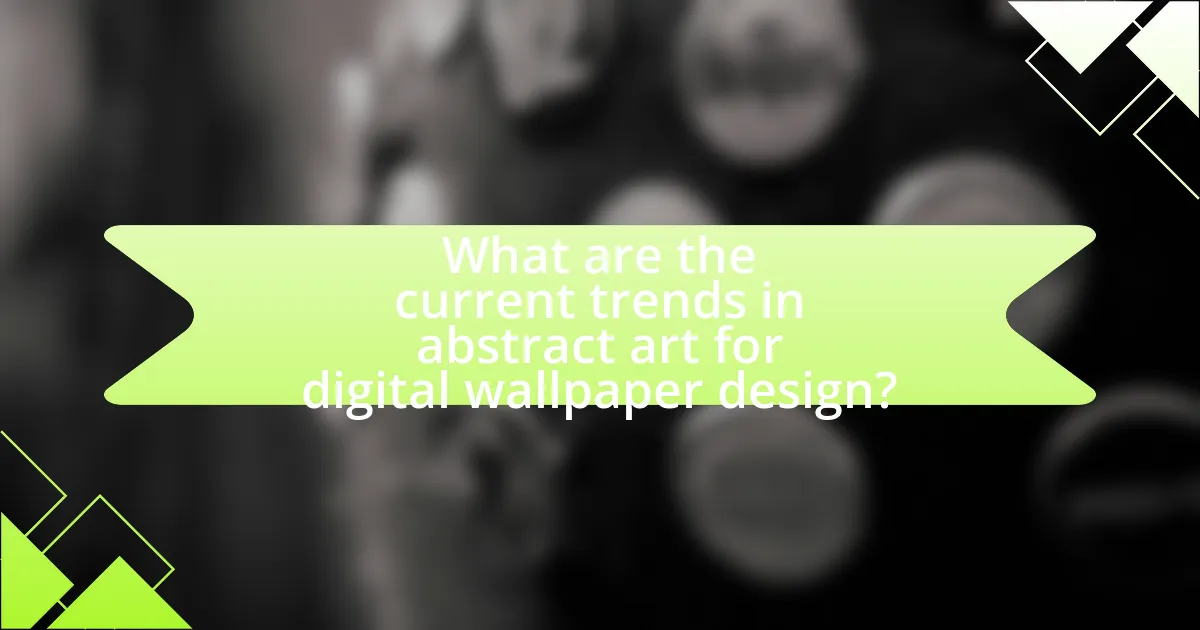
What are the current trends in abstract art for digital wallpaper design?
Current trends in abstract art for digital wallpaper design include the use of bold colors, geometric shapes, and organic forms. Designers are increasingly favoring vibrant palettes that evoke emotion and create visual impact, often incorporating gradients and textures to add depth. Additionally, there is a notable shift towards minimalism, where simplicity in design allows for a more sophisticated aesthetic. The integration of technology, such as augmented reality, is also emerging, enabling interactive wallpaper experiences. These trends reflect a broader movement towards personalization and the desire for unique, expressive spaces in interior design.
How are contemporary artists redefining abstract art in digital wallpapers?
Contemporary artists are redefining abstract art in digital wallpapers by integrating advanced technology and innovative design techniques that enhance visual engagement. These artists utilize digital tools such as software for 3D modeling, generative design, and augmented reality to create immersive and dynamic wallpaper experiences. For instance, artists like Refik Anadol employ algorithms to transform data into visually striking abstract patterns, allowing for a unique interplay between art and technology. This evolution reflects a shift from static images to interactive designs that can adapt to user preferences and environmental contexts, thereby expanding the boundaries of traditional abstract art.
What role does social media play in the promotion of abstract digital wallpapers?
Social media serves as a crucial platform for promoting abstract digital wallpapers by enabling artists and designers to showcase their work to a global audience. Through platforms like Instagram, Pinterest, and Facebook, creators can share visually appealing images, engage with followers, and utilize hashtags to increase visibility. For instance, a study by the Pew Research Center indicates that 72% of adults use at least one social media platform, providing a vast potential audience for digital art. Additionally, social media facilitates community building among artists and enthusiasts, fostering collaboration and feedback that can enhance the quality and reach of abstract digital wallpapers.
How are sustainability and eco-friendliness influencing current design trends?
Sustainability and eco-friendliness are significantly influencing current design trends by prioritizing materials and processes that minimize environmental impact. Designers are increasingly opting for sustainable materials, such as recycled or organic textiles, and implementing eco-friendly production methods that reduce waste and energy consumption. For instance, a report by the Ellen MacArthur Foundation highlights that the fashion and textile industries are moving towards circular economy practices, which emphasize reusing and recycling materials to create new products. This shift not only aligns with consumer demand for environmentally responsible options but also encourages innovation in design, leading to unique and sustainable aesthetic choices in digital wallpaper and other design fields.
What tools and technologies are essential for creating abstract digital wallpapers?
Essential tools and technologies for creating abstract digital wallpapers include graphic design software, digital painting applications, and high-resolution image editing tools. Software such as Adobe Photoshop and Illustrator are widely used for their extensive features that allow for intricate designs and manipulation of images. Additionally, applications like Procreate and Corel Painter enable artists to create unique textures and effects that are characteristic of abstract art. High-resolution monitors and graphic tablets enhance the design process by providing precision and clarity, which are crucial for detailed artwork. These tools collectively facilitate the creation of visually compelling abstract wallpapers that resonate with contemporary digital art trends.
What software is commonly used for designing abstract wallpapers?
Adobe Photoshop is commonly used for designing abstract wallpapers. This software provides a wide range of tools and features that allow artists to create intricate designs, manipulate images, and apply various effects. Additionally, Adobe Illustrator is frequently utilized for vector-based designs, enabling the creation of scalable abstract patterns. Both software options are industry standards, widely recognized for their capabilities in graphic design and digital art, making them essential for artists focused on abstract wallpaper creation.
How do digital tools enhance the creative process for artists?
Digital tools enhance the creative process for artists by providing innovative platforms for experimentation and expression. These tools, such as graphic design software and digital painting applications, allow artists to manipulate colors, shapes, and textures with precision and ease. For instance, programs like Adobe Photoshop and Procreate enable artists to create complex designs quickly, facilitating a more fluid creative workflow. Additionally, digital tools offer features like layering, undo options, and a vast array of brushes and effects, which empower artists to explore new styles and techniques without the limitations of traditional media. This flexibility not only accelerates the creative process but also encourages artists to push boundaries and innovate in their work, as evidenced by the rise of digital art movements and the increasing popularity of digital wallpaper design in contemporary art.
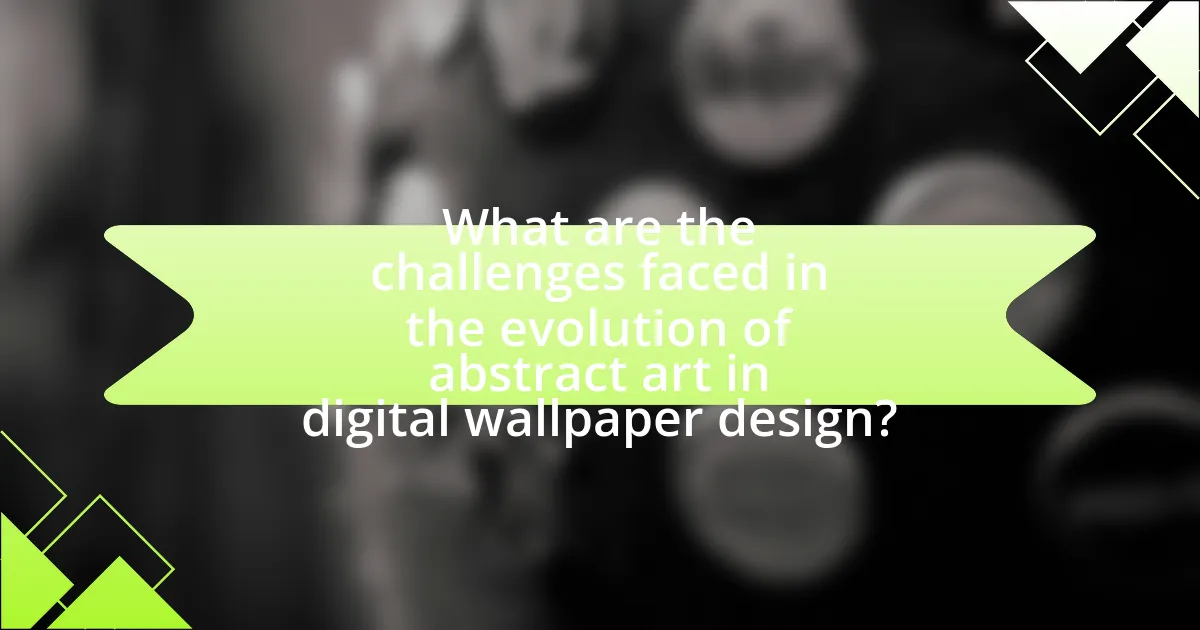
What are the challenges faced in the evolution of abstract art in digital wallpaper design?
The challenges faced in the evolution of abstract art in digital wallpaper design include the saturation of the market, technological limitations, and the balance between originality and commercial viability. Market saturation occurs as numerous designers create similar styles, making it difficult for new works to stand out. Technological limitations can restrict the complexity and quality of designs, as not all devices can render high-resolution images effectively. Additionally, designers often struggle to maintain originality while ensuring their work appeals to a broad audience, which can lead to compromises in artistic expression. These factors collectively hinder the growth and innovation of abstract art within the digital wallpaper sector.
What obstacles do artists encounter when creating abstract digital wallpapers?
Artists encounter several obstacles when creating abstract digital wallpapers, including technical limitations, creative block, and market saturation. Technical limitations can arise from inadequate software or hardware, which may hinder the artist’s ability to execute their vision effectively. Creative block often affects artists, making it challenging to generate new ideas or concepts, particularly in a genre that relies heavily on innovation and originality. Additionally, market saturation presents a significant challenge, as the abundance of available digital wallpapers can make it difficult for individual artists to stand out and gain visibility in a crowded marketplace.
How do copyright issues affect the distribution of abstract digital art?
Copyright issues significantly impact the distribution of abstract digital art by restricting unauthorized reproduction and distribution of the artwork. Artists retain exclusive rights to their creations, which means that any unauthorized use can lead to legal consequences, thereby limiting the availability of their work in various digital platforms. For instance, a study by the World Intellectual Property Organization indicates that copyright infringement can result in substantial financial losses for artists, as they may miss out on potential sales and exposure. Additionally, the complexity of copyright laws across different jurisdictions can create barriers for artists seeking to distribute their work internationally, further complicating the landscape of abstract digital art distribution.
What are the challenges of standing out in a saturated market?
The challenges of standing out in a saturated market include intense competition, consumer fatigue, and difficulty in differentiating products. In a market flooded with similar offerings, businesses struggle to capture attention and convey unique value propositions. For instance, a study by Nielsen indicates that 63% of consumers prefer brands that stand out from the competition, highlighting the necessity for distinct branding and innovative marketing strategies. Additionally, the overwhelming number of choices can lead to consumer indecision, making it harder for any single product to gain traction.
What best practices should artists follow when designing abstract digital wallpapers?
Artists should prioritize simplicity and balance when designing abstract digital wallpapers. Simplicity allows for a clean aesthetic that enhances visual appeal, while balance ensures that elements are distributed harmoniously across the composition. Utilizing a limited color palette can create a cohesive look, as evidenced by studies showing that artworks with fewer colors often resonate more with viewers. Additionally, incorporating texture can add depth and interest, making the wallpaper more engaging. Research indicates that textures can evoke emotional responses, further enhancing the wallpaper’s impact. Lastly, artists should consider the intended use of the wallpaper, ensuring that designs are versatile enough to fit various digital environments, which is crucial for user satisfaction.
How can artists effectively market their abstract digital wallpapers?
Artists can effectively market their abstract digital wallpapers by leveraging social media platforms, online marketplaces, and targeted advertising. Social media platforms like Instagram and Pinterest allow artists to showcase their work visually, reaching a broad audience interested in digital art. Online marketplaces such as Etsy and Redbubble provide a dedicated space for artists to sell their wallpapers directly to consumers. Additionally, targeted advertising on platforms like Facebook and Google can help artists reach specific demographics that are more likely to purchase abstract digital wallpapers. According to a 2021 report by Statista, 54% of consumers use social media to discover new products, highlighting the importance of these platforms in marketing strategies.
What tips can enhance the quality and appeal of abstract digital wallpaper designs?
To enhance the quality and appeal of abstract digital wallpaper designs, focus on using a balanced color palette, incorporating dynamic shapes, and ensuring high-resolution images. A balanced color palette creates visual harmony, which is essential for attracting viewers; studies show that color combinations can significantly influence aesthetic perception. Dynamic shapes add interest and movement, making the design more engaging; research indicates that asymmetrical compositions often capture attention more effectively than symmetrical ones. High-resolution images ensure clarity and detail, which are crucial for maintaining quality across various screen sizes, as pixelation can detract from the overall appeal.
